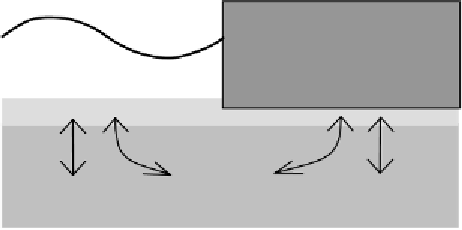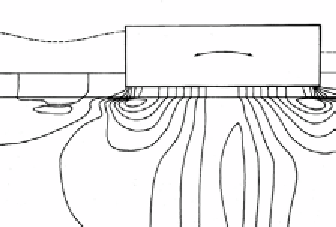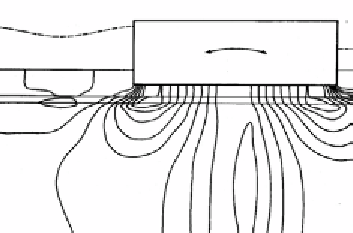Geoscience Reference
In-Depth Information
may occur occasionally, which invoke migration of particles (dynamic piping), and
without proper measures it may affect the stability of the structure.
' =
0
cos(
2
t
)
u =
0
cos(
2
t)
Figure 16.6 Combined conditions at the edge of a coastal structure
0.2
0.2
0.2
0.2
0.2
0.9
0.9
0.9
0.9
0.9
0.9
0.9
0.9
0.9
0.9
0.8
0.8
0.8
0.8
0.8
0.8
0.7
0.7
0.7
0.7
0.7
0.7
0.7
0.7
0.7
0.7
0.3
0.3
0.3
0.6
0.6
0.6
0.6
0.6
0.6
0.6
0.3
0.3
0.4
0.4
0.4
0.2
0.3
0.4 0.5
0.2
0.3
0.4 0.5
0.2
0.3
0.4 0.5
0.6
0.6
0.6
0.4
0.4
0.5
0.5
0.5
0.5
0.5
0.5
0.5
0.2
0.3
0.4
0.2
0.3
0.4
0.4
0.4
0.4
0.3
0.3
0.3
0.2
0.2
0.2
0.1
0.1
0.1
0.4
0.4
0.3
0.2
0.3
0.2
0.1
0.1
(a) two-layer foundation (b) three-layer foundation
Figure 16.7
An example of a numerical simulation of a two-dimensional cyclic consolidation
process involving the previously described condition at the edge of a rocking
coastal structure, on a shallow foundation and subjected to wave loading, is
presented in Fig 16.7, case (a) with a soft seabed with on top one coarse, relatively
stiff and permeable filter layer, and case (b) with a soft seabed, with on top a two-
layer filter bed consisting of coarse and finer softer material. The pore water is
assumed slightly compressible (some air intrusion due to wave action).
In Fig 16.7 isobar lines are presented, tagged with a number that shows the
excess pore pressure amplitude relative to the loading amplitude by the rocking
structure (rocking is significantly more severe than the wave itself). Local zones of
high pressures are observed, in agreement with aspects previously discussed.
Proper modelling of local gradients in these zones near interfaces of the filter bed is
achieved by a very fine FEM mesh. These gradients are essential in the design of a
stable filter bed under extreme loading conditions.
Multi-dimensional cyclic consolidation
The specific solution of cyclic consolidation problems in three dimensions
requires advanced mathematics. For stationary consolidation the volumetric
averaging method has been elaborated in Chapter 6
E
. Here, the same is used for
cyclic consolidation. Consider a general porous medium with volume
V
and surface

























Search WWH ::

Custom Search